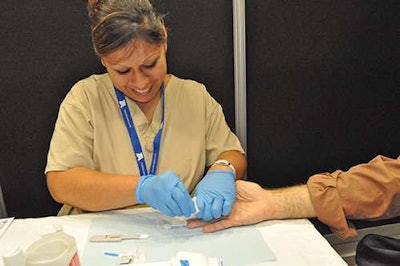 The test involves a painless fingerstick blood sample, with results available in 20 minutes.
The test involves a painless fingerstick blood sample, with results available in 20 minutes.Truckers are five times more likely than the general population to carry hepatitis C virus (HCV), a dangerous blood-born infection that can live in the body for up to 40 years with no symptoms.
To educate truck drivers about HCV and encourage them to get tested, the Healthy Trucking Association and its partners, OraSure Technologies and AbbVie, announced a nationwide initiative at The Great American Trucking Show. It’s called Truckers Rolling Against Hepatitis C.
Truck drivers can visit booth #23113 in the Health and Wellness Pavilion to get tested with OraSure’s OraQuick HCV Rapid Test. It’s the only FDA-approved test that provides lab-accurate results with a fingerstick blood sample in just 20 minutes, with 90 percent accuracy.
About 5.2 million people in the U.S. have been exposed to or are infected with HCV and three out of four don’t know it. Infected people can spread the disease even if they have no symptoms. Left untreated, HCV can lead to advanced liver disease and even liver cancer.
Once detected, HCV is treatable. “Previous treatments were hard on people so they would drop out and not continue treatment,” said Dr. Pam Thomas, M.D., who is working with the HTAA and other companies to educate drivers on HCV. “But now we have better medications on board that are easier to tolerate.”

After GATS, HTAA will announce additional testing locations at truck stops, fleets and clinics that serve the trucking community. Even truck drivers who have routine physicals with blood work should check with their family doctors to be sure they have been tested, since testing for HCV is not always standard practice.
Baby boomers, those born between 1946 and 1964, are most likely to carry the virus, especially if they had a blood transfusion or organ transplant in years prior to pre-screening of blood and organs.
Other risks include military service in combat, sharing needles or razorblades, snorting drugs with a straw or dollar bill and unprotected sex. Infected mothers can also spread the virus to their unborn children.
The virus can live outside the body for 16 hours to four days, even if the blood is dried. Most of those infected have no symptoms, but those who do may experience fatigue, joint pain, dark urine, belly pain, and jaundice.












